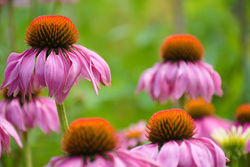How to find the right type of mulch
- Lars Wildes
- Feb 3, 2023
- 7 min read
Updated: May 14, 2023
Mulching is one of those words that you hear every spring and fall. You even hear it on all of the landscaping shows on TV and even when real estate agents talk about ‘curb appeal’.
But mulching is way more than just an easy way to make your borders and flower beds look nice, it’s also the easiest way to maintain a healthy and thriving garden.
It involves placing a protective layer around plants and trees and over bare soil. This layer is called mulch, and it can be made from materials such as bark, grass trimmings, wood chips, pine needles, straw, cocoa bean shells, black plastic, landscaping fabric, recycled tires, pebbles, and river rock.

From conserving soil moisture to suppressing weeds and reducing soil erosion, learning how to mulch may be the nicest thing you do for your garden this spring.
In this article, we’ll explore the biggest advantages of mulching, the best types to use, and why spring is the perfect time to start.
What is mulch and why should every gardener use it
Mulch is a layer of organic or inorganic material placed on top of the soil in gardens and landscapes.
Think of it like making a deposit in the bank. Your plants have withdrawn nutrients from the soil all growing season and winter.
Now, in the spring, you need to add to the soil to give them what they need as they prepare to grow and bloom again. (Plus, adding mulch in the spring is a great way to control weeds before they get out of hand.)
Top 5 reasons to start mulching now
Controls weeds — I’ll admit, this is my favorite reason to mulch. It acts as a barrier, limiting the amount of sunlight that can find its way to the weeds.
Retains soil moisture — Both organic and non-organic varieties of mulch cover the soil and limit evaporation. This is especially important during hot, dry seasons, and it’ll help you save on your water usage.
Keeps nutrients in the soil — Not only does mulch keep soil nutrients from being washed away with the rain, but as the organic material slowly decomposes on top of the soil, it releases much-needed nutrients down to the plants’ roots.
Encourages earthworms — Have you checked your compost pile lately? I bet it’s filled with earthworms busy at work breaking down the material and improving the structure of the compost. When you use organic mulch, they’ll come to that, too. And they’ll help break it down and improve soil structure and nutrient cycling.
Makes everything look better — Like we’ve all seen on TV, mulch can give a garden, border or even the front of your house a totally new, finished look. It’s a great way to fill in empty spaces and it’s super easy to maintain — just add a fresh layer on top.

What season should I put down mulch?
You can apply mulch any time of the year depending on what you’re after.
Here’s what I mean. If you want to use mulch as decorative ground cover, apply it any day of the year. It freshens up a border or makes a solitary tree look stately in an instant.
If you’re adding mulch because you want to enrich the soil for the sake of your perennials and other flowering plants, it’s best to apply it in the autumn or spring. This gives the organic material time to slowly break down and release its nutrients into the soil.
If you’re adding mulch to suppress weeds, add it before the weeds start to take over — I suggest early spring. You can add mulch directly on top of existing weeds (like in the summer), but if you don’t add a thick enough layer, they can easily pop through.
Overall, you get the biggest benefits from mulching in the spring. Hands down. You’ll get fewer weeds, have better soil moisture, add nutrients to the soil, and your flower beds will look gorgeous.
Now, don’t expect one spring application of mulch to change your life.
If you’re dealing with poor soil, it’ll take more than just a layer to get your garden Chelsea Flower Show ready. But over time — applying mulch every autumn and spring — your soil will improve dramatically. And who knows… maybe you’ll win gold.
Where is mulch best applied?
The best thing about mulch is that there is no wrong way to apply it.
Add a layer around 2-4" thick (5-10 cm) around the base of all plants and trees.
Try to avoid direct contact with the stems or trunks. I always mulch in the spring or fall because the summer months are just too warm, and I don't want to overheat the soil and risk damaging my plants.
Always mulch after weeding if possible.
Do you have to remove last year’s mulch?
A lot of gardeners suggest removing old mulch, but I think it’s completely unnecessary.
Leave the old mulch in place and add new mulch directly on top. This saves time… and why would I remove the old mulch? It’s busy breaking down and depositing healthy nutrients into the soil.

What are the disadvantages of mulch?
Over-mulching can lead to suffocation of the roots and, because of super moist soil, it can cause crown rot in plants.
Mulch can also attract pests such as termites and rodents, which damage plants and trees in your garden. Mulch can also harbor harmful fungi and bacteria, which can be transferred to plants and cause disease.
With that being said, the advantages of mulching far outweigh the cons. If you’re concerned you’ll overdo it, start with a thin layer around the base of your plants and trees and see how it goes.
What type of mulch is best?
The best mulching materials are ones that break down over time (so don't use plastic).
My favorites include wood chips or bark (good insulation and lasts a long time), compost (adds fertility to the soil as it decomposes), straw or hay (good for weed suppression but decomposes quickly), leaves (great insulation and adds organic matter to the soil), pine needles (perfect for acid-loving plants).
Wood chips or bark mulch is a good choice for evergreen trees such as cedar
Straw or hay mulch is great for annual flowers and vegetable gardens
Composted leaves are perfect mulch for perennials and shrubs such as lilacs
Pine needles are great for acid-loving plants like blueberries, hydrangeas and rhododendrons
In my garden, it’s leaves all the way. Leaves provide humus and fulvic acid to the soil and make the soil more moisture-holding.
I rake and collect leaves in plastic bags during the fall and winter. Then, in the spring and fall, I add a 3-inch layer (7 cm) of dry plant leaves around my borders to make healthy soil that recharges itself with organic matter.
Notice that plastic mulch or landscaping fabric isn’t on my list. While these inorganic mulches are used a lot in commercial gardening, try to always choose an organic material.
Really anything that degrades and adds nutrition to the soil can work as mulch.

Is mulch the same as compost?
No, mulch and compost are not the same things.
Mulch is a layer of organic or inorganic material applied to the surface of the soil to retain moisture, regulate temperature, suppress weeds, and improve soil structure.
Compost is a mixture of decayed organic matter added to the soil to improve its fertility and structure. While compost can be used as mulch, mulch is not the same as compost and does not have the same nutrient content or soil-improving properties.
To get the most benefit from your garden, use both mulch and compost.
Mix compost into the soil and apply mulch on top.
Compost in the soil. Mulch on top of the soil.
The do's and don'ts of choosing mulch
When choosing mulch, look for materials free of weed seeds and disease, and always avoid materials treated with chemicals.
Always choose a plant-based material — like wood chips, grass trimmings, bark, leaves, pine needles, straw, hay, etc.
Is it possible to make your own mulch?
Any gardener can easily make their own mulch using yard waste such as leaves, grass clippings, and plant trimmings.
To make mulch, simply pile up the yard waste, moisten it, and cover it with a tarp or put it in large plastic garbage bags.
Over time, the material will decompose into a compost-like material that can be used as mulch.
In a hurry? You can also lay newspapers around the base of your plants. Be sure to water them so they lay flat on the ground.
You Asked — We Answered
Is stone or mulch better?
It depends on what you want. Organic mulch will provide nutritional value. Stone will only help suppress weeds, nothing else.
Instead of stone, consider these different types of organic mulch:
Wood chips are ideal for use in perennial beds or around trees or shrubs and can be a decorative addition to any landscape.
Pine is slightly more acidic than other varieties making it a strategic addition for plants needing a more acidic environment.
Nutrition-dense compost can be used as a standalone mulch or a healthy boost to plants, providing a continuous supply of nitrogen and carbon. Because it decomposes quickly, add additional layers of material each month during peak growing season.
Grass clippings are an effective weed suppressant but should be used sparingly as they can emit an unpleasant odor and prevent the transmission of water if the layer is too thick.
Leaf mulch is attractive to earthworms and is a great way to get rid of the leaves on your property.
Which is better for plants, chipped mulch or shredded mulch?
Chipped mulch tends to wash away faster than shredded mulch when it’s on a bank or hill and there are heavy rains.
Shredded mulch also holds together and blocks weed growth better than chips. But, chipped mulch is easier to apply and takes longer to compost or break down, meaning it lasts longer. That’s why you see it most often used as a border for trees and shrubs, not for flowers or veg gardens
Shredded mulch often needs to be applied both in the spring and fall whereas bark or chipped mulch can last a full season and only needs one application annually depending on the environment.
If you’re not sure, I suggest going with chipped mulch because you don’t have to apply it as often and it lasts longer.
Are fallen leaves good for mulch?
Absolutely! They break down quickly, feed worms, fungi, and important microbes in the soil, and increase organic matter. You’ll be adding carbon, sulfur, phosphorus, nitrogen, and potassium into your soil.
And it’s easy to collect them in the fall and winter and apply them right away to your borders, trees and shrubs.






Comments